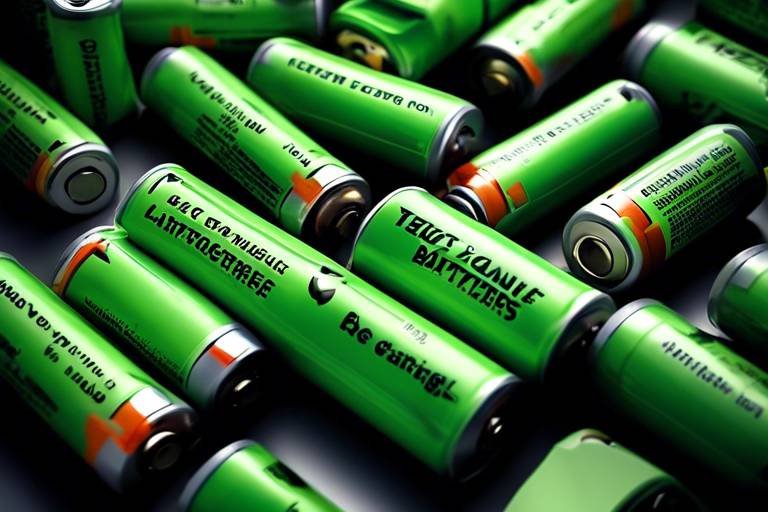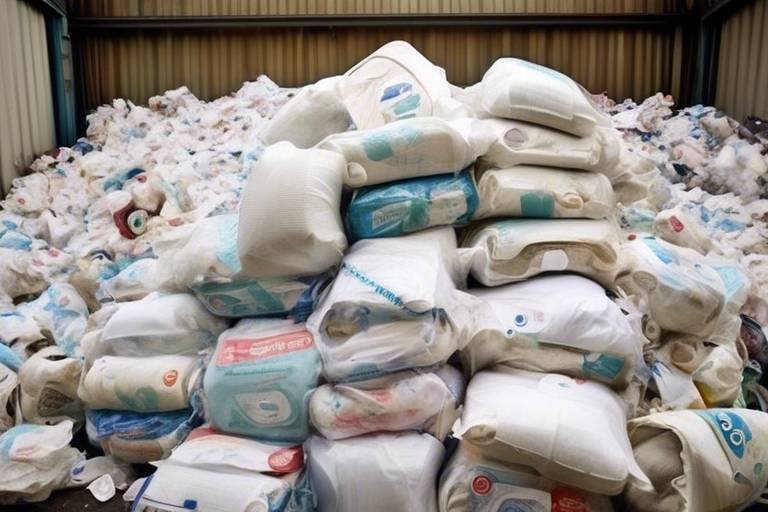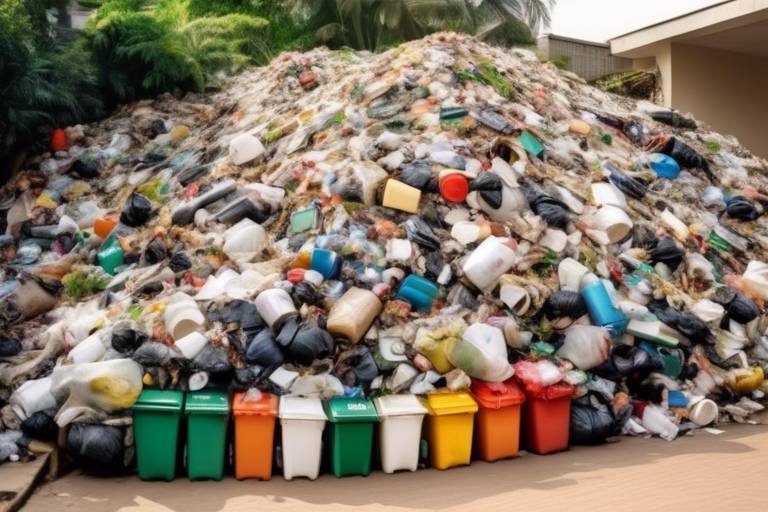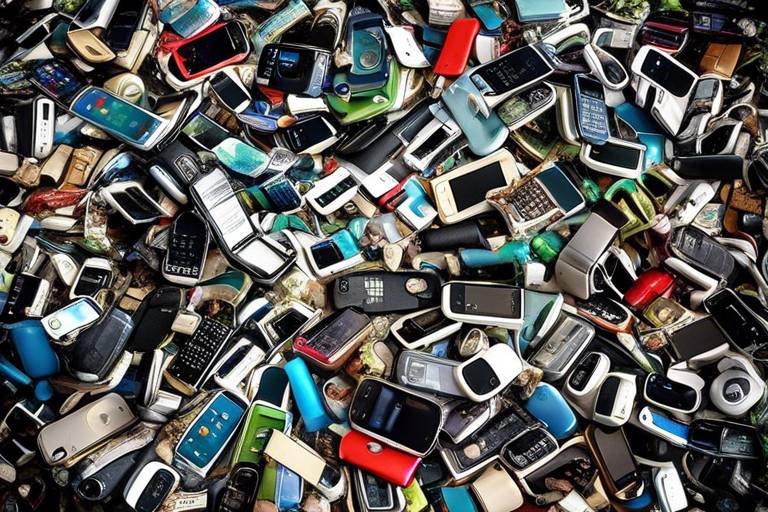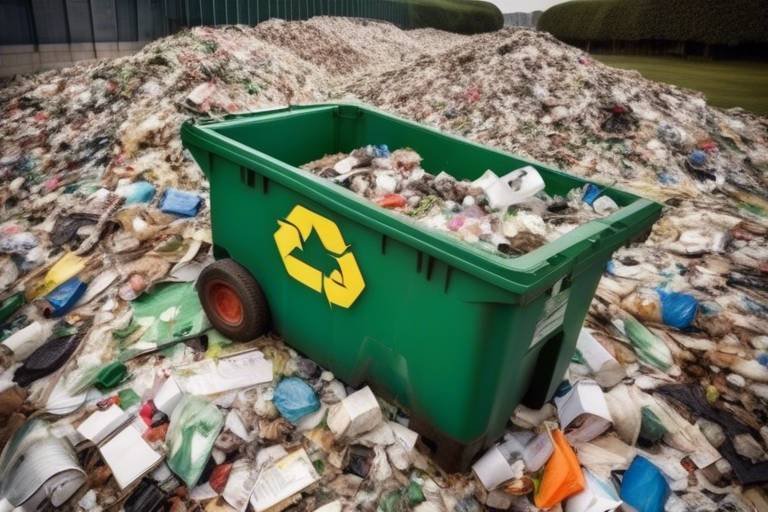Are Rechargeable Batteries Better for the Environment?
In today's world, where environmental concerns are at the forefront of public discourse, the question of whether rechargeable batteries are better for the environment than their disposable counterparts is more relevant than ever. As we strive to reduce our carbon footprint and minimize waste, understanding the impact of our everyday choices becomes crucial. Rechargeable batteries, which can be used repeatedly, present a compelling case for sustainability. But what makes them stand out?
To begin with, rechargeable batteries have a significantly longer lifespan compared to disposable batteries. While a typical alkaline battery may last for a few hours or days, a rechargeable lithium-ion battery can be recharged hundreds, if not thousands, of times. This longevity translates into fewer batteries being produced, consumed, and ultimately discarded. Imagine the difference it makes when you only need to buy a single rechargeable battery instead of a dozen disposable ones over time!
Moreover, the production of disposable batteries often involves the extraction of raw materials, which can lead to environmental degradation. The mining processes required for materials like lithium, cobalt, and nickel can be quite destructive. In contrast, rechargeable batteries, while still requiring some mining, can mitigate this impact through their extended use. By opting for rechargeable batteries, consumers can contribute to a more sustainable cycle of resource use, effectively reducing the demand for new raw materials.
Another key aspect to consider is the waste management implications. Disposable batteries often end up in landfills, where they can leach harmful chemicals into the soil and groundwater. This not only poses a risk to local ecosystems but also affects human health. On the other hand, rechargeable batteries, when disposed of properly, can be recycled and repurposed, significantly reducing their environmental impact. This recycling process can recover valuable materials, further promoting sustainability.
In summary, while both battery types have their pros and cons, the evidence increasingly points to rechargeable batteries as the more environmentally friendly option. They offer a longer lifespan, reduced resource extraction, and a lower risk of pollution when properly recycled. So, the next time you're faced with the choice between disposable and rechargeable batteries, remember the bigger picture—your choice can make a difference!
- How long do rechargeable batteries last? Rechargeable batteries can last for several years, depending on the type and usage, often providing hundreds to thousands of charge cycles.
- Are rechargeable batteries more expensive? While the upfront cost may be higher, rechargeable batteries tend to be more cost-effective in the long run due to their longevity.
- Can rechargeable batteries be recycled? Yes, rechargeable batteries can and should be recycled to recover valuable materials and minimize environmental impact.
- What types of devices use rechargeable batteries? Many devices, including smartphones, laptops, cameras, and electric vehicles, use rechargeable batteries.

Understanding Battery Types
When it comes to powering our devices, understanding the different types of batteries is crucial. Batteries are not just simple power sources; they come in various forms, each with its own chemical composition and application. The two main categories of batteries are rechargeable and disposable, and knowing the distinctions between them can help us make informed choices that benefit both our wallets and the environment.
Disposable batteries, often referred to as single-use batteries, are designed to be used once and then discarded. Common examples include alkaline batteries, which power everything from remote controls to flashlights. These batteries contain heavy metals such as mercury, cadmium, and lead, which can leach into the environment when they end up in landfills. On the other hand, rechargeable batteries, like nickel-metal hydride (NiMH) or lithium-ion (Li-ion), can be used multiple times, significantly reducing waste.
To illustrate the differences, here’s a quick comparison:
| Type | Rechargeable | Disposable |
|---|---|---|
| Usage | Multiple uses | Single use |
| Environmental Impact | Lower | Higher |
| Cost Over Time | More cost-effective | More expensive over time |
| Common Applications | Smartphones, laptops, cameras | Remote controls, toys, flashlights |
Rechargeable batteries are not only more sustainable but also more economical in the long run. While the initial cost may be higher, the ability to recharge and reuse them makes them a smart investment. Imagine buying a pack of disposable batteries every month versus investing in a single rechargeable battery that lasts for years. It’s like comparing a one-time meal at a restaurant to cooking at home; the latter often proves to be better for your budget and the planet!
In conclusion, understanding these battery types is essential for making choices that align with our environmental values. By opting for rechargeable batteries, we can contribute to a healthier planet while also saving money. So, next time you're in the store, remember: your choice of battery can make a difference!

The Environmental Impact of Disposable Batteries
Disposable batteries are often viewed as convenient solutions for powering our everyday devices, but their environmental impact is anything but simple. When we toss a single-use battery into the trash, we unknowingly contribute to a growing problem that affects our planet. These batteries contain a cocktail of hazardous materials, including heavy metals like lead, mercury, and cadmium, which can seep into the soil and waterways, posing serious risks to wildlife and human health. The sheer volume of disposable batteries used annually is staggering; in fact, millions are discarded every year, leading to significant accumulation in landfills.
Once in landfills, disposable batteries can take years, if not decades, to decompose. During this time, the toxic substances within them can leach out, contaminating the surrounding environment. For example, a single alkaline battery can release enough mercury to pollute over 1,000 gallons of water. This is a shocking statistic that highlights the urgent need for more sustainable battery options. The impact doesn't stop at pollution; the extraction of raw materials necessary for battery production also leads to habitat destruction and increased carbon emissions, further exacerbating environmental issues.
Moreover, the disposal of batteries is not just a local issue; it has global ramifications. Countries around the world are grappling with the consequences of improper battery disposal. In developing regions, where waste management systems may be lacking, the effects can be even more pronounced. The accumulation of hazardous waste can lead to health crises, affecting communities that rely on contaminated water sources. The need for a shift towards more sustainable practices has never been clearer.
To combat these challenges, many organizations and governments are advocating for better recycling programs and stricter regulations on battery production. Some of the steps being taken include:
- Implementing mandatory recycling programs for batteries.
- Raising public awareness about the importance of proper battery disposal.
- Encouraging manufacturers to design batteries that are easier to recycle and less harmful to the environment.
In conclusion, the environmental impact of disposable batteries is profound and multifaceted. From pollution to resource depletion, the consequences of our reliance on single-use batteries are far-reaching. As consumers, we hold the power to make a difference by choosing more sustainable alternatives, such as rechargeable batteries, which can significantly reduce waste and conserve precious resources.
1. What are the main environmental hazards of disposable batteries?
Disposable batteries contain heavy metals and toxic chemicals that can leach into the environment, contaminating soil and water sources.
2. How long does it take for a disposable battery to decompose?
Disposable batteries can take decades to decompose, during which time they can release harmful substances into the environment.
3. What can I do with used batteries?
It's crucial to recycle used batteries properly. Many retailers and local waste management facilities offer battery recycling programs to ensure safe disposal.
4. Are there regulations on battery disposal?
Yes, many countries have regulations in place that require the recycling of batteries and impose penalties for improper disposal.
5. Why should I switch to rechargeable batteries?
Rechargeable batteries are more environmentally friendly as they reduce waste, conserve resources, and often save consumers money in the long run.

Benefits of Rechargeable Batteries
When it comes to making environmentally friendly choices, rechargeable batteries stand out as a beacon of sustainability. Unlike their single-use counterparts, these batteries offer a multitude of benefits that not only save you money but also help in conserving our planet's resources. Imagine the number of disposable batteries that end up in landfills each year—it's staggering! By opting for rechargeable batteries, you can significantly reduce waste and contribute to a greener future.
One of the most compelling advantages of rechargeable batteries is their cost-effectiveness. Although the initial purchase price might be higher than that of disposable batteries, the long-term savings are undeniable. Rechargeable batteries can be used hundreds, if not thousands, of times, which means you’re not constantly buying replacements. To put this into perspective, consider the following:
| Battery Type | Average Cost per Battery | Recharge Cycles | Total Cost Over 5 Years |
|---|---|---|---|
| Disposable | $1.50 | N/A | $150 (100 batteries) |
| Rechargeable | $3.00 | 500 | $30 (1 battery, used 500 times) |
As you can see from the table, the cost of using rechargeable batteries is significantly lower over time. This is because you can recharge them multiple times, making them a smart investment for your wallet.
Moreover, rechargeable batteries have a longer lifespan compared to disposable ones. While a typical alkaline battery may last a few hours or days depending on usage, a rechargeable battery can provide consistent power for a much longer duration. This not only enhances user experience but also means fewer batteries are produced, reducing the environmental strain associated with manufacturing.
Another noteworthy benefit is the reduced environmental footprint. The production and disposal of disposable batteries contribute to pollution and resource depletion. By switching to rechargeable batteries, you are actively participating in a cycle that promotes sustainability. Rechargeable batteries are designed to be reused and can be recycled at the end of their life, thus minimizing their impact on the environment. It’s like trading a one-time-use plastic bag for a durable, reusable tote—one decision can lead to a world of difference!
Furthermore, the technological advancements in rechargeable batteries have led to improvements in their efficiency and performance. Innovations such as lithium-ion technology have made these batteries lighter, more powerful, and capable of holding a charge for extended periods. This means that whether you're powering your remote control, camera, or electric vehicle, you can rely on rechargeable batteries to deliver consistent and reliable performance.
In conclusion, the benefits of rechargeable batteries extend far beyond just saving money. They represent a shift towards a more sustainable lifestyle, reducing waste, and conserving precious resources. As we become more aware of our environmental impact, making the switch to rechargeable options is not just a smart choice—it's a necessary one for our planet's future.
- How long do rechargeable batteries last?
Rechargeable batteries can last anywhere from 2 to 10 years depending on the type and usage. - Can I use rechargeable batteries in all devices?
Most devices that use disposable batteries can also use rechargeable ones, but it's always best to check the manufacturer's recommendations. - Are there any safety concerns with rechargeable batteries?
While generally safe, it's important to follow the manufacturer's guidelines for charging and storage to avoid potential hazards.

The Lifecycle of Rechargeable Batteries
The lifecycle of rechargeable batteries is a fascinating journey that highlights their potential for sustainability and environmental conservation. Understanding this lifecycle is crucial for anyone interested in making eco-friendly choices. So, let’s break it down into three key phases: production, usage, and disposal. Each phase plays a significant role in determining the overall impact of these batteries on our planet.
First, let’s talk about production. The process of manufacturing rechargeable batteries involves extracting raw materials, such as lithium, cobalt, and nickel. These materials are often mined from the earth, which can lead to environmental degradation and pollution if not done responsibly. However, advancements in technology are making production more efficient and less harmful. For example, companies are increasingly using recycled materials in battery production, reducing the need for virgin resources. This shift not only conserves natural resources but also minimizes the carbon footprint associated with mining and refining these materials.
Next up is the usage phase. Rechargeable batteries are designed to be used multiple times, which significantly extends their lifespan compared to disposable batteries. For instance, a single rechargeable battery can replace hundreds of disposable ones, resulting in less waste. This longevity translates into a lower overall environmental impact, as fewer batteries need to be produced, transported, and disposed of. Additionally, many rechargeable batteries are designed to be more efficient, providing higher energy density and longer usage times, which means they can power devices for extended periods without needing a recharge.
Finally, we arrive at the disposal phase. It’s essential to handle rechargeable batteries correctly at the end of their life cycle. Unlike disposable batteries, which can leach harmful chemicals into the environment when thrown away, rechargeable batteries can be recycled. Many manufacturers and retailers offer take-back programs where consumers can return their old batteries for proper recycling. This process not only prevents harmful substances from entering landfills but also allows valuable materials to be recovered and reused. In fact, recycling can reclaim up to 95% of the materials in a lithium-ion battery, making it a much more sustainable option.
To summarize, the lifecycle of rechargeable batteries demonstrates a clear advantage over disposable batteries. By focusing on responsible production, efficient usage, and proper disposal, we can significantly reduce our environmental impact. As consumers, understanding this lifecycle empowers us to make informed choices that contribute to a more sustainable future.
- What are the main components of rechargeable batteries? Rechargeable batteries typically consist of materials like lithium, cobalt, and nickel, which are essential for their function and efficiency.
- How long do rechargeable batteries last? Depending on the type and usage, rechargeable batteries can last anywhere from 2 to 10 years, with some models capable of being recharged hundreds of times.
- Can rechargeable batteries be recycled? Yes, rechargeable batteries can be recycled, and many retailers and manufacturers offer programs to facilitate this process.
- Are there environmental risks associated with rechargeable batteries? While rechargeable batteries are generally more environmentally friendly than disposable ones, their production and disposal still pose risks if not managed properly.

Recycling and Disposal Practices
When it comes to minimizing the environmental impact of batteries, recycling and proper disposal practices are absolutely crucial. Many people may not realize that batteries contain a range of materials that can be harmful if they end up in landfills. For example, disposable batteries often contain heavy metals like lead, cadmium, and mercury, which can leach into the soil and water, causing significant pollution. This is where recycling comes into play, offering a responsible way to handle battery waste.
Recycling programs specifically designed for batteries are becoming more widespread, and they allow consumers to dispose of their used batteries safely. In fact, many retailers and local waste management facilities now offer dedicated battery recycling bins. These programs not only help prevent hazardous materials from contaminating the environment but also allow for the recovery of valuable materials that can be reused in new batteries. Did you know that up to 90% of a battery's components can be recycled? That's a staggering number and emphasizes the importance of recycling.
To make the recycling process easier, here are some common practices you can follow:
- Locate a Recycling Center: Many communities have established recycling centers where you can drop off your used batteries. Websites like Call2Recycle can help you find a location near you.
- Participate in Retail Programs: Many electronics and retail stores have battery recycling programs. Look for designated bins in stores like Best Buy or Home Depot.
- Check Local Guidelines: Some municipalities have specific regulations regarding battery disposal, so it's essential to stay informed about local laws.
Additionally, it's important to note that not all batteries can be recycled in the same way. For instance, lithium-ion batteries, commonly used in smartphones and laptops, require specific handling due to their chemical composition. Improper disposal can lead to fires or explosions, making it even more critical to follow proper recycling protocols.
In terms of disposal, if recycling isn't an option, it's vital to avoid throwing batteries in the regular trash. Instead, look for hazardous waste collection events in your area, where you can safely dispose of batteries along with other electronic waste. These events are typically organized by local governments or environmental organizations and are a great way to ensure that your waste is handled responsibly.
In conclusion, adopting proper recycling and disposal practices for batteries is not just a personal responsibility; it's a collective effort to protect our environment. By making informed choices and participating in recycling programs, we can significantly reduce the harmful effects of battery waste. Remember, every small action counts, and together, we can pave the way for a cleaner, greener future.
Q1: Can all types of batteries be recycled?
A1: Not all batteries can be recycled in the same way. While many rechargeable batteries can be recycled, some disposable batteries may require special handling. Always check local guidelines.
Q2: What happens to batteries when they are recycled?
A2: When batteries are recycled, they are processed to recover valuable materials like lead, nickel, and lithium, which can be used to make new batteries or other products.
Q3: How can I find a recycling center for batteries near me?
A3: You can use online resources like Call2Recycle to locate battery recycling centers in your area.
Q4: Is it safe to throw batteries in the regular trash?
A4: No, it is not safe to throw batteries in the regular trash. They can leak harmful chemicals and cause environmental damage. Always dispose of them through proper recycling or hazardous waste programs.

Consumer Choices and Behaviors
When it comes to making choices about batteries, consumers often find themselves at a crossroads, weighing convenience against sustainability. The truth is, our daily decisions can have a profound impact on the environment. As awareness grows about the detrimental effects of disposable batteries, many are beginning to consider the long-term benefits of rechargeable options. This shift in mindset is not just a trend; it's a necessary evolution in our consumption habits.
One of the biggest factors influencing consumer behavior is education. As people become more informed about the environmental consequences of their purchases, they are more likely to choose products that align with their values. For instance, did you know that rechargeable batteries can be reused up to 1,000 times? This impressive statistic alone highlights their potential to drastically reduce waste. However, despite knowing this, many still cling to the convenience of disposables. Why? It often boils down to familiarity and perceived effort.
Additionally, marketing plays a crucial role in shaping consumer perceptions. Companies that promote the sustainability of their rechargeable batteries can sway public opinion. Consumers are drawn to brands that not only offer quality products but also demonstrate a commitment to environmental responsibility. This is where the power of branding comes into play, as eco-friendly labels and certifications can significantly influence purchasing decisions.
Moreover, the accessibility of rechargeable batteries has improved significantly over the years. They are now available in various forms, from AA and AAA to specialized batteries for cameras and electronics. This wider availability means that consumers are more likely to encounter rechargeables in their everyday shopping, making it easier to make a sustainable choice. However, the price point can still be a barrier for some. While rechargeable batteries may cost more upfront, their longevity and reusability often make them more economical in the long run.
In conclusion, consumer choices and behaviors regarding batteries are evolving, driven by a combination of education, marketing, and accessibility. As more people become aware of the environmental impact of their choices, we can expect a continued shift towards rechargeable batteries. This change is not just beneficial for the planet; it's a win-win for consumers looking to save money and reduce waste.
- Why should I choose rechargeable batteries over disposable ones?
Rechargeable batteries can be reused multiple times, reducing waste and saving you money in the long run. - How do I properly dispose of rechargeable batteries?
Many retailers and local recycling centers offer programs for safe disposal of rechargeable batteries. Always check local guidelines. - Are rechargeable batteries more expensive?
While they may have a higher initial cost, their ability to be reused makes them more economical over time. - Can I use rechargeable batteries in all devices?
Most devices are compatible with rechargeable batteries, but it's essential to check the manufacturer's recommendations.

Technological Advancements in Battery Design
The world of battery technology is evolving at an astonishing pace, and it's not just about making batteries that last longer. Recent technological advancements have transformed how we think about energy storage, efficiency, and sustainability. Imagine a battery that not only powers your devices but also does so with minimal impact on our planet. That's the future we're heading toward!
One of the most significant breakthroughs in battery design has been the development of solid-state batteries. Unlike traditional lithium-ion batteries, which use liquid electrolytes, solid-state batteries utilize solid electrolytes. This change enhances safety by reducing the risk of leaks and fires, which are common in conventional batteries. Additionally, solid-state batteries can potentially offer higher energy densities, meaning they can store more energy in a smaller space. This is a game-changer for everything from electric vehicles to portable electronics.
Another exciting innovation is the rise of lithium-sulfur batteries. These batteries promise to be lighter and more efficient than their lithium-ion counterparts. The use of sulfur, an abundant and inexpensive material, not only lowers the cost of production but also significantly reduces environmental impact. Imagine charging your phone less frequently while using a battery that is more eco-friendly—this is the kind of future we can expect with lithium-sulfur technology.
Moreover, advancements in recycling technologies are playing a crucial role in battery sustainability. Companies are now developing methods to recover valuable materials from used batteries, such as lithium, cobalt, and nickel. This not only helps in reducing waste but also lessens the demand for new raw materials, which can be harmful to the environment. For instance, closed-loop recycling systems are being implemented to ensure that battery materials are reused rather than discarded.
As we look to the future, we can expect even more innovations in battery technology. Researchers are exploring alternatives like graphene batteries, which promise to be faster-charging and longer-lasting. These batteries could revolutionize the way we power our devices, making charging times a thing of the past. With the potential for improved performance and lower environmental impact, graphene batteries represent a significant leap forward in battery design.
In conclusion, the advancements in battery technology are not just about enhancing performance; they are also about making our energy consumption more sustainable. With innovations such as solid-state and lithium-sulfur batteries, coupled with improved recycling practices, we are on the brink of a new era in energy storage. As consumers, we should remain informed and excited about these developments, as they hold the key to a greener future.
- What are solid-state batteries? Solid-state batteries use solid electrolytes instead of liquid ones, enhancing safety and energy density.
- How do lithium-sulfur batteries differ from lithium-ion batteries? Lithium-sulfur batteries are lighter, more efficient, and use sulfur, which is cheaper and more abundant.
- Why is battery recycling important? Recycling helps recover valuable materials, reduces waste, and lessens the need for new raw materials, which can harm the environment.
- What is graphene battery technology? Graphene batteries are a new type of battery that promises faster charging and longer-lasting performance compared to traditional batteries.

Future Trends in Battery Usage
The landscape of battery usage is on the brink of a revolutionary transformation. As we stand at the intersection of technology and sustainability, it’s clear that the future of batteries is not just about powering devices but also about reducing environmental impact and enhancing efficiency. With the increasing demand for energy storage solutions, particularly in the realms of renewable energy and electric vehicles, innovative technologies are emerging that promise to change the way we think about batteries.
One of the most exciting trends is the development of solid-state batteries. Unlike traditional lithium-ion batteries that use liquid electrolytes, solid-state batteries utilize solid electrolytes, which can significantly improve safety and energy density. This means they can hold more energy in a smaller space, leading to longer-lasting devices and vehicles. Imagine an electric car that can travel much farther on a single charge—this is the future that solid-state technology is paving the way for.
Furthermore, researchers are exploring the use of alternative materials to reduce reliance on scarce resources like cobalt and lithium. For instance, sodium-ion batteries are gaining traction as a more abundant and sustainable alternative. These batteries could revolutionize the market by providing a less expensive and more environmentally friendly option. The shift towards these alternative materials not only helps in conserving resources but also minimizes the ecological footprint associated with mining and production.
Another trend gaining momentum is the integration of batteries with renewable energy sources. As solar and wind energy become more prevalent, the need for efficient energy storage solutions is paramount. Batteries that can store energy generated from these sources will play a crucial role in creating a sustainable energy ecosystem. This synergy between batteries and renewable energy can lead to a significant reduction in greenhouse gas emissions, making it a win-win situation for both consumers and the planet.
Moreover, advancements in battery recycling technologies are also on the rise. As the number of batteries in circulation increases, so does the need for effective recycling solutions. Innovative methods are being developed to recover valuable materials from old batteries, reducing the need for new raw materials and minimizing waste. This not only supports sustainability but also drives down costs in the long run. For example, companies are now able to recycle over 90% of the materials in lithium-ion batteries, which is a huge leap forward.
In summary, the future of battery usage is bright and filled with potential. As we embrace these trends, we can expect to see batteries that are not only more efficient and powerful but also more sustainable. The convergence of technology and environmental responsibility will lead us towards a future where energy storage is no longer a challenge but a solution. Are you ready to embrace this electrifying future?
- What are solid-state batteries? Solid-state batteries use solid electrolytes instead of liquid, making them safer and more energy-dense.
- Why are alternative materials important for batteries? They reduce reliance on scarce resources and minimize environmental impact during production.
- How do batteries integrate with renewable energy? Batteries store energy generated from renewable sources, ensuring a consistent energy supply.
- What advancements are being made in battery recycling? New technologies can recover over 90% of materials from used batteries, promoting sustainability.
Frequently Asked Questions
- Are rechargeable batteries really better for the environment?
Absolutely! Rechargeable batteries can significantly reduce waste because they can be used multiple times. This means fewer batteries end up in landfills, which helps decrease pollution and resource depletion. Plus, they often have a lower carbon footprint over their lifecycle compared to disposable batteries.
- What are the main differences between rechargeable and disposable batteries?
Rechargeable batteries can be charged and reused many times, while disposable batteries are designed for one-time use. Rechargeables typically have a higher upfront cost but save money in the long run due to their longevity. Additionally, they contain different chemical compositions that can be more environmentally friendly.
- How do disposable batteries harm the environment?
Disposable batteries can leak harmful chemicals, such as heavy metals, into the soil and water when they decompose in landfills. This contamination poses serious risks to wildlife and human health. Moreover, the production of disposable batteries consumes valuable resources and energy, further contributing to environmental degradation.
- What are the key benefits of using rechargeable batteries?
Rechargeable batteries offer several perks! They are cost-effective over time, have a longer lifespan, and reduce waste. They also tend to perform better in high-drain devices, making them a practical choice for gadgets like cameras and gaming controllers.
- What should I know about the lifecycle of rechargeable batteries?
The lifecycle of rechargeable batteries includes production, usage, and disposal. Each stage impacts the environment. Understanding this lifecycle helps consumers make informed choices about their battery usage and encourages responsible recycling and disposal practices.
- How can I properly recycle or dispose of batteries?
It’s crucial to recycle batteries properly to minimize their environmental impact. Many communities have recycling programs specifically for batteries. Always check local guidelines to find out where you can drop off used batteries safely!
- What role do consumer choices play in battery sustainability?
Consumer choices are vital! When consumers opt for rechargeable batteries, they help drive demand for more sustainable products. Increased awareness and education about the environmental impacts of batteries can lead to more eco-friendly purchasing decisions.
- What are some recent advancements in battery technology?
Recent innovations include improved materials that enhance battery efficiency and longevity. Technologies like lithium-sulfur and solid-state batteries are making waves, offering higher energy densities and faster charging times, all while being more sustainable.
- What are the future trends in battery usage?
The future looks bright! We’re seeing a shift towards renewable energy sources and more efficient energy storage solutions. As technology advances, we can expect batteries to become even more sustainable, with alternative materials and improved recycling methods taking center stage.

